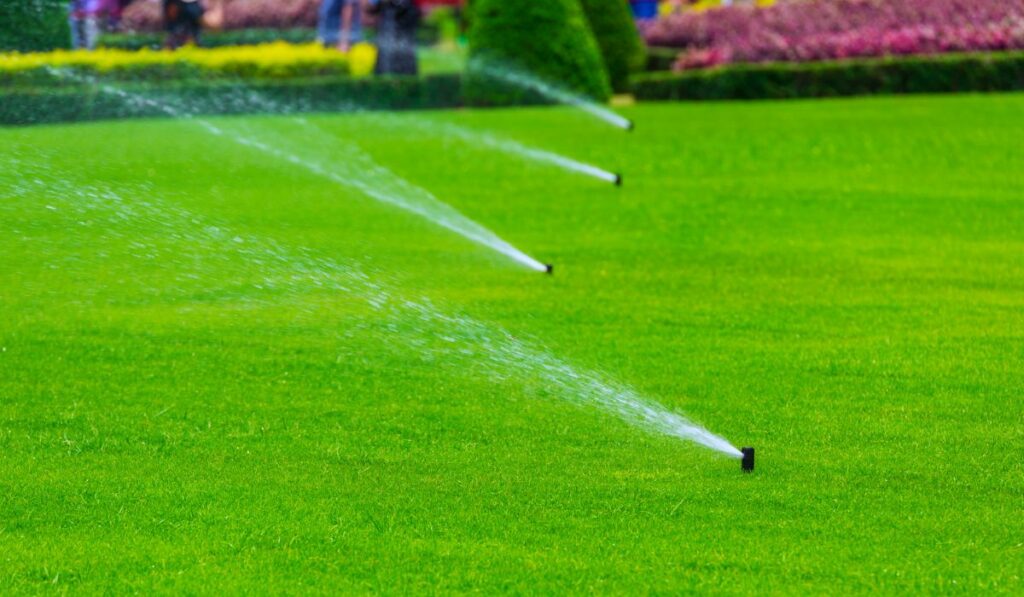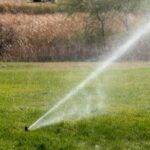Achieving and maintaining a healthy lawn requires regular care, and that includes watering. But when is the best time to water your lawn? What are the consequences of watering at the wrong time? And how long should you water? The answers may surprise you.
Healthy grass needs about 1-1.5 inches of water per week. The rule of thumb is to water for 30 minutes early in the morning, twice a week. If you live in a hot and dry climate, you may need to water more often and for longer periods. Wetter areas may only need watering once a week.
Let’s take a closer look at when to water your lawn for the best results, including how often you should turn on your sprinklers and how different grass types can affect your watering schedule. Plus, we’ll go through some tips for determining the water output of your sprinklers and whether you should water your grass after mowing.
When’s the Best Time of Day to Run Your Sprinklers?

The best time of day to water your lawn is in the early morning before the sun comes up. At this time of day, the temperature is cooler, and there’s less wind, so the water will have a chance to soak into the ground before evaporating.
If you water in the middle of the day, the heat will cause the water to evaporate before it reaches the roots of your grass. Plus, the sun will dry out the surface of the grass, so the water won’t be able to penetrate as deeply.
Watering in the evening also isn’t ideal, as the water will sit on the surface of the grass all night, potentially leading to fungal growth or diseases like rust — a type of fungal infection that causes red or orange spots on the leaves.
Pests like chinch bugs are also more active at night, and they’re more likely to attack your grass when it’s wet.
How Long Should Your Sprinklers Run For?
You should water your lawn long enough for the water to penetrate 4-6 inches into the soil. One way to check is to stick a screwdriver or garden trowel into the ground to see how far down the moisture has penetrated. Or, you can use a moisture meter (on Amazon).
If your soil is dry just a few inches below the surface, you need to water more frequently but for shorter periods to help the water penetrate deeper into the ground without run-off.
If you have sandy soil, you may need to water more frequently because sandy soils don’t hold moisture as well as clay or loam soils. Conversely, if your soil is mostly clay, you may be able to water less frequently because clay soils hold moisture better.
Experiment to see how often your particular grass needs to be watered. Try watering your lawn for 30 minutes every other day and sticking your screwdriver into the ground to see how far down the moisture has penetrated. If it’s only wet a few inches below the surface, you should water more frequently.
Watering your lawn for the right amount of time is just as important as watering it at the right time of day. If you over-water your yard, the water will simply run off the surface instead of getting absorbed into the ground, leading to water-logging, which can damage your grass and make it more susceptible to disease.
If you don’t water your lawn for long enough, meanwhile, the roots won’t get enough moisture, and the grass will brown and die.
How Frequently Should You Turn on Your Sprinklers?
A general rule of thumb is to water your lawn for about 30 minutes twice a week, though you may need to adjust this depending on how hot or dry it is where you live.
How often you turn on your sprinklers depends on a few factors, including the type of grass you have, the climate you live in, and how much rain has fallen recently. Most types of grass need about 1 to 1.5 inches of water per week.
Grass, like all plants, evolved to adapt to the conditions in its environment. The roots of grasses grow deep into the ground to access water and nutrients, which helps them survive during periods of drought.
When grass is exposed to too much water, the roots can rot, leading to disease and pests. Overwatered lawns are also more susceptible to weeds. But when the grass is not getting enough water, the blades will turn brown and start to die.
If you live in an area with a lot of rainfall, you may not need to water your lawn as often. But your grass will need more water to stay healthy if it hasn’t rained in a while and the temperatures are high.
If the soil is dry, it’s time to turn on the sprinklers. If the soil is soggy, wait a few days before watering again.
The best way to know how often to water your lawn is to check the soil. The soil should be moist to about 6 inches below the surface. You can use a garden trowel to check the soil’s moisture level.
Should You Water Your Grass After Mowing?
Whether you should water your grass after mowing depends on a few factors, including the time of day, whether your grass needs water, and if your watering schedule is on track.
If you’ve mowed early in the day and your lawn shows signs that it needs moisture, like wilting or footprints remaining in the grass, you should water your lawn.
But if you’re mowing during the hotter midday hours, it’s best to wait to water. Watering during the heat of the day can cause evaporation rather than giving your lawn a chance to absorb moisture. Instead, wait until the following morning to water.
If you mow in the evening, it’s best to wait until the next morning to water when the lawn will have time to absorb moisture before nightfall. If you water at night, the grass will stay wet and is more susceptible to disease.
If you’re following a regular watering schedule and your grass is hydrated and healthy, you likely don’t need to water immediately after mowing.
Overall, the best thing you can do for your lawn is to keep up with a regular watering schedule. Watering deeply and less often is better for grass than watering a little every day. Then you can mow around your watering schedule without worrying about whether to water immediately after mowing.
How to Determine the Water Output of Your Sprinklers
You’ll need to do a test to find out how much water your sprinklers put out. You can do this by putting an empty bucket under the sprinkler and seeing how long it takes to fill the bucket up.
Once you know how much water your sprinkler puts out in a certain amount of time, you can calculate how long it would take to water your whole yard.
For example, let’s say it takes your sprinkler 10 minutes to fill up a 5-gallon bucket. That means that in one hour, your sprinkler can output 300 gallons of water (60 minutes x 5 gallons). So if you have a half-acre lawn, this would be plenty of time to give your yard a deep watering.
But if your sprinklers take 30 minutes to fill up a 5-gallon bucket, it would output only 100 gallons of water in one hour. In this case, consider running your sprinklers longer or getting a more powerful sprinkler system.
In general, it is best to water your lawn deeply and less frequently, so you would want to set your sprinklers to run for a longer period less often, as opposed to shorter periods more often.
How Grass Type Affects Your Watering Schedule

One of the first things you need to consider when deciding how often to water your lawn is the type of grass you have.
Different grasses have different watering needs. For example, Bermuda grass and zoysia grass are warm-season grasses that do best in hot weather. They can go longer between watering than cool-season grasses like ryegrass and fescue, which require more frequent watering.
Here are some general guidelines for watering different grass types:
- Bermuda grass and zoysia grass: every 5-7 days
- Fescue grass: 3-4 times per week
- Perennial ryegrass: 2-3 times per week
- Kentucky bluegrass: every 7-10 days
If your lawn is a mix of different grass types, water according to the needs of the grass that is dominant. Lawn coverings like clover or moss will also affect how often you need to water since they hold moisture in the soil longer than grass. Your lawn will need less frequent watering if they’re present.








